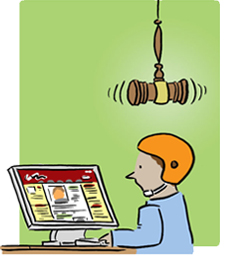Rule 6. Consider What You Copy.
Copyright and trademark infringement claims are cropping up in connection with blogging, social network use, and other Internet activities. Sometimes these threats aim to bully Internet users into removing content they are entitled to post. But there also may be legitimate intellectual property interests in question. It’s better to anticipate problems and recognize when you’re within your rights in using someone else’s work, than risk being blindsided by unexpected claims and demands down the line.
So before you cut and paste some third party’s content, whether it’s a logo, photo, text, music, video, or other form of intellectual property, consider whether copyright or trademark concerns may come into play. (For information on disclosure of trade secrets, see Rule 5.) It’s also helpful to understand that often those who are asserting claims, sometimes in the form of cease and desist letters and sometimes as add-on claims in libel lawsuits, may be overreaching.
Copyrights protect the originator or assigned copyright holder’s expression of ideas. They restrict the use of content to protect the owner’s intellectual property rights and the owner’s ability to profit from creative work.
Which forms of expression are covered by copyrights? From the United States Copyright Office, a broad list of categories.
Trademarks, according to the United States Patent and Trademark Office, “protect words, names, symbols, sounds, or colors that distinguish goods and services from those manufactured or sold by others and . . . indicate the source of the goods.”
Bloggers and other citizen journalists are more likely to run across legitimate copyright law issues than true trademark problems, except when it comes to the use of titles. Trademark restrictions generally do not limit noncommercial use of trademarks or use of trademarks in news reporting and new commentary. Titles, however, which as a rule don’t have copyright protection, can cause trademark problems. Avoid the use of domain names and other titles that might be confused with another’s trademark.
Examples:
O.K. If orange soda is sold in your daughter’s middle school cafeteria and you’re posting on the high-calorie lunch crisis, you can use the manufacturer’s logo to illustrate your story.
Not O.K. If you’re launching your own soda business and use your Web site as a marketing tool, posting another manufacturer’s logo could cause consumer confusion.
O.K. Posting a feature story on your blog about local politics entitled, “A Perfect Storm.”
Not O.K. Using “Eebay” for your domain name or blog URL.
Most uses of trademarks by bloggers and other citizen journalists posting on issues, interests and concerns would fall into permitted areas.
However, because trademark owners must defend their marks or risk losing trademark protection, there is always a possibility that a blogger or other citizen journalist who uses another’s trademark in their online activities might be confronted by a cease and desist letter. While these letters typically demand that citizen journalists remove content, in the trademark context, they’re often more bluster than rooted in any plausible claim.
In terms of copyrights, do not assume that because information is available to you online, it is in the public domain and you’re free to use it without restriction. If someone sends you an e-mail, or if you find a fabulous photo online, you can’t automatically conclude you can legally copy that content without some checking and/or analysis. It can take some investigating to determine who, if anyone, owns the copyright in a creative work. Someone can own an original photo or video or written work without having any right to reproduce it. Even museums have run into problems putting images of artworks they own on their Web sites. That’s because rights to the expression of ideas, whether in the form of text, images or audio, generally belong to the creator or any other owner to whom rights were contractually assigned by the creator/originator. An author can own and retain copyrights without registering his or her work.
What can you generally copy safely? Click here to find out.
Blustery Threats
For bloggers and online contributors seeking to substantiate their reporting with documentary evidence, there are many judgment calls that must be made about when too much uploading or cutting and pasting can put one at risk of violating copyright law. You might want to post a portion of an autobiographical passage from a politician for a profile, or a movie clip for a film review. Unfortunately, when it comes to how much is too much, as the U.S. Copyright Office makes clear, there often are no definitive answers.
Perhaps because there are so many grey areas under copyright law in terms of what’s protected, individuals and organizations that seek to limit online publication often invoke copyrights to threaten bloggers and online contributors. One online contributor who posted a negative review of a local animal hospital received a warning about the negative commentary. The contributor posted the warning, only to receive a threat that posting the warning was a copyright violation.
Is that possible? We know that at least some letters can have copyright protection. In the United States, J.D. Salinger’s letters were found to have copyright protection as literary works. But could that protection extend to e-mailed warnings or, for that matter, to cease and desist letters? In a recent decision in the U.K., a business letter was found to have copyright protection as a literary work. However, if you receive a cease and desist letter or other warning, posting the communication and an explanation of the circumstances would likely be considered a fair use. The Electronic Frontier Foundation recommends posting cease and desist letters through Chilling Effects Clearinghouse, which maintains a database of cease and desist letters.
(c) Geanne Rosenberg









